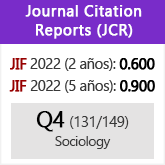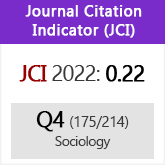¿Disidencia dentro del feminismo?
DOI:
https://doi.org/10.3989/ris.2007.02.15Palabras clave:
Acoso, Ideología del género, Feminismo disidente, Violación en una cita, ViolenciaResumen
En este trabajo se examina una nueva corriente de pensamiento surgida dentro del movimiento feminista norteamericano, que disiente de algunos de los principales presupuestos epistemológicos del feminismo, y que denuncia sus efectos, tanto en la población americana, en especial dentro de la comunidad académica, como en la agenda pública. Las autoras que han emprendido la crítica de la denominada “ideología del género” cuentan por un lado con el apoyo de una gran parte del público americano. Por otra parte, han suscitado la ira del feminismo académico que les atribuye ser parte de un backlash (un contraataque) frente a los logros conseguidos por el feminismo. Son acusadas, entre otras cosas, de conservadurismo, traición a la causa feminista o acoso institucional antifeminista. El grado de crispación se ha elevado con la crisis de “las violaciones en las citas” que se ha convertido en la nueva causa feminista, junto con las actuales políticas contra la pornografía y el acoso sexual. A todo esto, se añade el surgimiento de voces disidentes en Canadá, Francia y España, que confirman una grave fractura dentro de uno de los movimientos sociales más importantes de las últimas décadas.
Descargas
Citas
Aronson, P. (2003), “Feminists or post feminists?”, Gender and Society, 17 (6): 903-921. doi:10.1177/0891243203257145
Audet, E. (2003, Septiembre 29), “Elisabeth Badinter desnaturaliza el feminismo para combatirlo mejor. Una crítica de Por mal camino”, sisyphe.org. Artículo disponible en: http://sisyphe.org/article.php3?id_article=598. Traducido al castellano por “Ciudad de Mujeres”.
Badinter, E. (2004), Por mal camino, Madrid, Alianza.
Beauvoir, S. (2005 [1949]), El segundo sexo, Madrid, Cátedra.
Bethea, A. R., K. R. Rexrode, A. C. Ruffo y S. D. Washington (1999), “Violence in lesbian relationships: a narrative analysis”, Poster presentado en el Encuentro Anual de la American Psychological Association, Boston.
Burton, A. (1992), “History is now: feminist theory and the production of historical feminisms”, Women’s History Review, 1 (1): 25-38. doi:10.1080/09612029200200001
Chesler (2006), “The failure of feminism”, The Chronicle of Higher Education Review, 52 (25): B12.
Chwe, M. (2001), Rational rituals: culture, coordination and common knowledge, Princeton, Princeton University Press.
Clark, V., S. Nelson Garner, M. Higonnet y K. Katrak (eds.) (1996), Antifeminism in the academy, Nueva York, Routledge.
Coleman, V. E. (1994), “Lesbian battering: The relationship between personality and the perpetration of violence”, Violence and Victims, 9 (2): 139-152.
Duffy, M. (1992), “The Bete Noire of Feminism time”, Time, disponible en: www.time.com/time/magazine/article/0,9171,974660,00.html.
Daphne, P. (año), Heterophobia: Sexual Harassment and the Future of Feminism (Lanham, MD: Rowman & Littlefield).
Ebert, T. L. (1996), Ludic feminism and after postmodernism, desire, and labor in late capitalism, Ann Arbor, University of Michigan Press.
Elster, J. (1982), Explaining technical change, Cambridge, Cambridge University Press.
Faludi, S. (1991), Backlash, The Underdeclared War Against American Women. Nueva York, Doubleday.
Farrell, W. (1986), The myth of male power, Nueva York, Berkley.
Farrell, W. (1993), The Liberated man, Nueva York, Berkley.
Fisher, B. S., y F. T. Cullen (2000), “Measuring the sexual victimization of women: evolution, current controversies, future research”, en Duffee, D. (ed.), Criminal Justice, Vol. 4, Measurement and analysis of crime and justice. Washington, DC, U.S. Department of Justice, National Institute of Justice, pp. 317-390.
Flanders, L. (1994), “The Stolen Feminism Hoax: Anti-Feminist Attack Based on Error-Filled Anecdotes”, FAIR, artículo disponible en: http://www.fair.org/index.php?page=1246.
Gelb, J. (2006), “Backlash in the US and Japan”, Comunicación presentada en el panel del comité RC 19 del congreso de IPSA. Disponible en: ipsa-rc19.anu.edu.au/Gelb.ipsa06.pdf.
Gilbert, N. (1998), “Realities and mythologies of rape”, Society, 35 (2): 4- 10. doi:10.1007/BF02838163
Gilbert, N. (1991), “The phantom epidemic of sexual assault”, Public Interest, vol. 10 (3), pp. 54-65.
Gilbert, N. (1995), Was It rape? An examination of sexual assault statistics. Menlo Park, California, Henry J. Kaiser Family Foundation.
Gurin, P. (1985), “Women’s gender consciousness”, Public Opinion Quarterly, 49 (2): 143-63. doi:10.1086/268911
Harding, S. (1996), Feminismo y ciencia, Madrid, Ediciones Morata.
Husak, D. y G. Thomas (1992), “Date Rape, Social Convention and Reasonable Mistakes”, Law and Philosophy, 11: 5-126. doi:10.1007/BF01000919
Kaminer, W. (1990), A fearful freedom: women’s flight from equality, Nueva York, Addison Wesley Publishing.
Koss, M. P. y S. L. Hamby (2003), “Shades of gray: a qualitative study of terms used in the measurement of sexual victimization”, Psychology of Women Quarterly, 27 (3): 243–255. doi:10.1111/1471-6402.00104
Koss, M. P. y R. Warshaw (1988), I Never Called It Rape: The Ms. Report on Recognizing, Fighting and Surviving Date and Acquaintance Rape, Ms. Magazine/Sarah Lazin Books.
Koss, M. P. y C. A. Gidycz (1985), “The sexual experiences survey: reliability and validity”, Journal of Consulting and Clinical Psychology, 53, 3: 442–443. doi:10.1037/0022-006X.53.3.422 PMid:3874219
Koss, M. P., C. A. Gidycz y N. Wisniewski (1987), “The scope of rape: incidence and prevalence of sexual aggression and victimization in a national sample of higher education students”, Journal of Counselling and Clinical Psychology, 55 (2): 162–170. doi:10.1037/0022-006X.55.2.162 PMid:3494755
Koss, M. P. y C. Oros (1982), “Sexual experiences survey: A research instrument investigating sexual aggression and victimization”, Journal of Consulting and Clinical Psychology, 50 (3): 455–457. doi:10.1037/0022-006X.50.3.455 PMid:7096751
Krahe, B., R. Scheinberger-Olwig, y S. Kolpin (2000), “Ambiguous Communication of Sexual Intentions as a Risk Marker of Sexual Aggression”, Sex Roles, 42 (5/6): 313-337. doi:10.1023/A:1007080303569
Kurt z, S. (2001, diciembre 5), “Silencing Sommers. Clinton holdovers have their way with HHS”, The National Review, disponible en: http://www.nationalreview.com/contributors/kurtz120501.shtml.
Laframboise, D. (1996), Princess at the window: a new gender morality, Toronto, Penguin Books. Lambert, T. A., A. S. Kahn y K. J. Apple (2003), “Pluralistic ignorance and hooking up”, Journal of Sex Research, 40 (2): 129–133.
Lehrman, K. (1997), The lipstick proviso: women, sex and power in the real world, Nueva York, Doubleday.
Lerner, R., A. K. Nagai y S. Rothman (1995), Molding the good citizen. The politics of high school history texts, Westport, Praeger.
Lipovetsky, G. (1999), La tercera mujer, Barcelona, Anagrama.
Mackinnon, C. (1993), “Feminism, marxism and the state”, Signs, 8: 43-58.
Miller, L. M. (2007), “Coordinación y acción colectiva”, Revista Internacional de Sociología 46: 161-182.
Muehlenhard C. L. y L. C. Hollabaugh (1988), “Do women sometimes say no when they mean yes? The prevalence and correlates of women’s token resistance to sex”, Journal of Personality and Social Psychology, 54 (5): 872-879. doi:10.1037/0022-3514.54.5.872 PMid:3379584
Muehlenhard, C. L. y Z. D. Peterson (2005), “Wanting and not wanting sex: the missing discourse of ambivalence”, Feminism and Psychology, 15 (1), pp. 15–20. doi:10.1177/0959353505049698
O’Sullivan, L. F. y E. R. Allgeier (1994), “Disassembling a stereotype: Gender differences in the use of token resistance”, Journal of Applied Social Psychology, 24: 1035-1055. doi:10.1111/j.1559-1816.1994.tb02372.x
Paik, A., E. O. Laumann y M. Van Haitsman (1999), Sexual jealousy, violence and embeddedness in intimate relations: a social structural cultural explication, Chicago, Universidad de Chicago.
Page, S. (2006), “Feminism and the third wave: politicising the sociology of religion?”, Comunicación presentada en la University of Leeds, UK, e-paper n.º 17.
Paglia, C. (2006), Sexual personae, Madrid, Valdemar.
Paglia, C. (2001), Vamps and tramps, Madrid, Valdemar.
Paglia, C. (1992), Sex, art, and American culture, Toronto, Vintage Books.
Patai, D. (1998), Heterophobia: sexual harassment and the future of feminism, Natlonal Book Network
Patai, D. (2000), “Speak freely”, Chronicle of Higher Education, vol. 46 (40), pB7, 2p, 2c.
Patai, D. (2003), “The great tattling scares on campuses”, Chronicle of Higher Education, 49 (21) pB11, 2p.
Pineda, E. (2006), “Un feminismo que también existe”, El País, disponible en: http://www.pensamientocritico.org/emppin0306.htm.
Ravitch, D., E. Chester, y Jr. Finn (1987), What do our 17-year-0lds know? A report on the first national assessment of history and literature, Nueva York, Harper and Row.
Renzetti, C. M. (1988), “Violence in lesbian relationship. A preliminary analysis of causal factors”, Journal of Interpersonal violence, 3 (4): 381-399. doi:10.1177/088626088003004003
Roiphe, K. (1994a), “Date rape’s other victim”, New York Times Magazine, Nueva York.
Roiphe, K. (1994b), The morning after. Sex, fear and feminism, Boston, Back Bay Books.
Schoenberg, N. y S. Roe (1993), “The Making of an Epidemic. A Three-Day Series”, Toledo, Blade.
Simon, R. (1995), Neither victim nor enem: Women’s Freedom Network looks at gender in America, Nueva York, Women’s Freedom Network, University Press of America.
Sommers, C. (1994), Who stole feminism? How women have betrayed women, Nueva York, Touchstone.
Sommers, C. (1995, marzo 15), “Christina Hoff Sommers reply to charges disseminated by the left wing media watchdog group FAIR, disponible en: http://www.debunker.com/texts/fair2.html
Sommers, C. (2001), La Guerra contra los chicos. Como un feminismo mal entendido está dañando a los jóvenes, Madrid, Ediciones Palabra.
Sprecher, S., E. Hatfield, A. Cortese, E. Potapova y A. Levitskaya (1994), “Token resistance to sexual intercourse and consent to unwanted sexual intercourse: College students’ dating experiences in three countries”, Journal of Sex Research, 31: 125-132.
Steinem, G. (1995), Revolución desde dentro. Un libro sobre la autoestima, Barcelona, Anagrama.
Stinchcombe, A. L. (1970), La construcción de las teorías sociales, Buenos Aires, Ediciones Nueva Visión.
The National Coalition of Anti-Violence Programs (1998), Annual Report on Lesbian, Gay, Bisexual, Transgender Domestic Violence.
Uriarte, E. (2008), Contra el feminismo, Madrid, Espasa.
Wolf, N. (1991), El mito de la belleza, Barcelona, Emecé.
Young, C. (1999), Ceasefire: why women and men must join forces to achieve true equality, Nueva York, Free Press.
Descargas
Publicado
Cómo citar
Número
Sección
Licencia
Derechos de autor 2009 Consejo Superior de Investigaciones Científicas (CSIC)

Esta obra está bajo una licencia internacional Creative Commons Atribución 4.0.
© CSIC. Los originales publicados en las ediciones impresa y electrónica de esta Revista son propiedad del Consejo Superior de Investigaciones Científicas, siendo necesario citar la procedencia en cualquier reproducción parcial o total.Salvo indicación contraria, todos los contenidos de la edición electrónica se distribuyen bajo una licencia de uso y distribución “Creative Commons Reconocimiento 4.0 Internacional ” (CC BY 4.0). Puede consultar desde aquí la versión informativa y el texto legal de la licencia. Esta circunstancia ha de hacerse constar expresamente de esta forma cuando sea necesario.
No se autoriza el depósito en repositorios, páginas web personales o similares de cualquier otra versión distinta a la publicada por el editor.

















